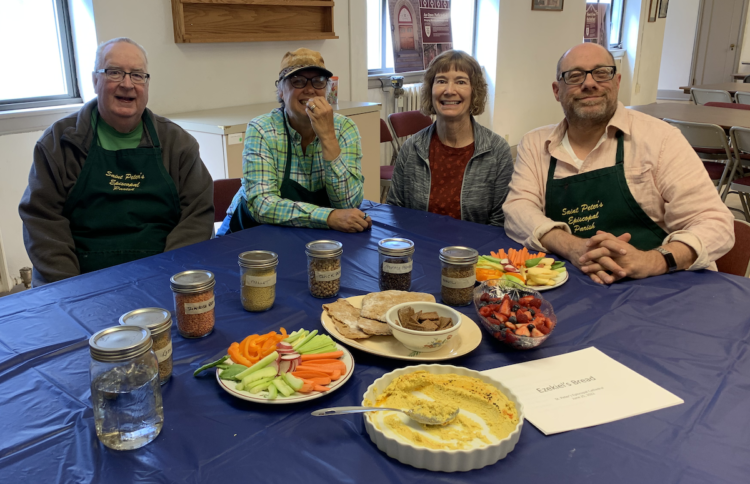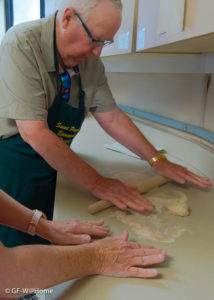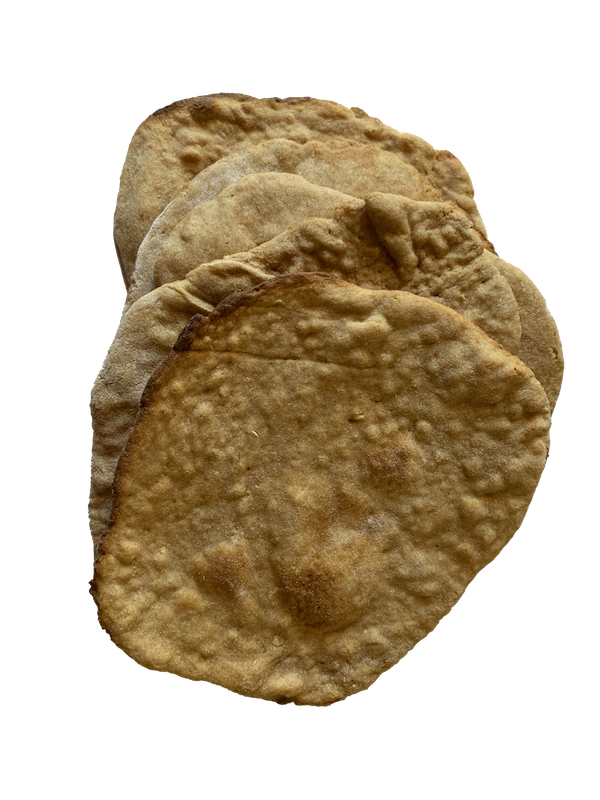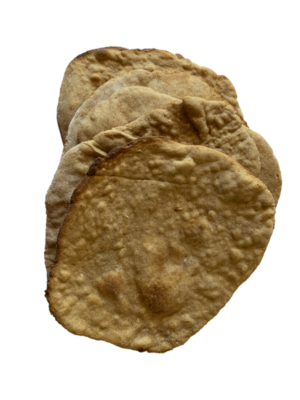Around 2600 years ago, in a Jerusalem threatened by siege, God told Ezekiel he would have to live on only bread and water for 390 days. Ezekiel’s challenge was to survive on a daily ration of just 8 ounces of bread and a little over 2 ½ cups of water. Is it possible to do that? Can you survive on just bread and water?
Survival Bread
Bread made from durum wheat flour, emmer wheat flour, barley flour, chickpea flour, lentil flour, and millet flour, and blended with olive oil, water, salt, and a small amount of sourdough starter, is a nutritionally valuable basic food. It contains complementary proteins from grains and legumes, a good supply of carbohydrate for energy, and all the necessary vitamins, minerals, phytonutrients, and unique fiber from the whole grains, for proper assimilation and use of that carbohydrate.
The sourdough provides protection against the growth of mold during the long rising time, it also provides flavor and is especially healthful since the sourdough acidity allows the natural enzymes in wheat to release minerals such as iron, zinc, and phosphorus from all the grains and legumes. [1]
God’s plan was to punish the population of Jerusalem for their sins. Ezekiel’s bread and water diet was meant to help them survive that punishment; it is not a balanced diet for a healthy life. While someone in good health could probably survive on Ezekiel’s bread and water ration, he/she would surely be sick and weak at the end of the siege.
Making Ezekiel’s Bread Part of Your Diet
Nutrition is not a mystery, however every day we read – or hear – about plant-based diets, super foods, nutrient density, “complete nutrition,” and dozens of diet plans such as Paleo and Keto diets. What to do?
Eating a well-balanced diet consisting of plenty of minimally processed organic fruits and vegetables and high-quality protein (plant- or animal-based) is a simple prescription for healthy families to follow. However we CAN supplement the plan with a nutritionally dense bread made with grains, pulses, and millet.
Dry-land Montana is home to grain farmers that grow durum wheat, emmer wheat, barley, chickpeas, lentils, and millet – nutritious grains close at hand! But, most of it is shipped out of the state and nearly none of it is milled into flour.
You can mill your own and bake your own. Bring your baking home and use local and regional grains, pulses, and seeds. It’s the healthy thing to do.

Ezekiel’s Bread – Lunch and Learn, St. Peter’s Cathedral
While the bread Ezekiel was instructed to bake was a “punishment bread” and part of a bread and water diet to be eaten for 390 days, it was a special kind of bread that made it possible to survive on such skimpy fare.
An inquisitive group came together at St. Peter’s to learn more about the value of combining pulses and grains for better nutrition. We patted, rolled, and baked flat breads that sometimes refused to cooperate. The solution? Roll that recalcitrant dough back into a ball and try again!

In the end we had tasty bread for dipping into fresh hummus. And we shared conversation and concerns about the challenge of eating good food in a world that is full of grocery retailers offering “edible food-like substances” containing chemicals and toxins of which most of us are totally unaware. Ezekiel could sit at a table filled with the average American fare and barely recognize any of it as real food.
The time has come for us to look back at real and simple foods that are good for us, good for the farmers and ranchers, and good for the land and soil. Watch for the next in our Good Food Series at St. Peter’s Cathedral, Helena.
Baking Ezekiel Bread
 This recipe is for flat breads. Even though the recipe includes flour from three kinds of grains, none of them have gluten strong enough to support a substantial rise to dough made of nearly 30 percent gluten-free flours. Sorry, no boules or baguettes here. The bread resembles a rustic pita bread and it should be served immediately after baking or steamed for a few minutes before serving to soften and warm the bread.
This recipe is for flat breads. Even though the recipe includes flour from three kinds of grains, none of them have gluten strong enough to support a substantial rise to dough made of nearly 30 percent gluten-free flours. Sorry, no boules or baguettes here. The bread resembles a rustic pita bread and it should be served immediately after baking or steamed for a few minutes before serving to soften and warm the bread.
Note: While you can grind all the grains, pulses, and millet at home in even a small coffee grinder, it takes a lot of time. I was able to buy five of the various flours, except the lentil flour, in local markets. The coffee grinder worked perfectly for the small amount of lentil flour needed.
Ingredients
- 250 grams Kamut® Khorasan wheat flour
- 150 grams emmer flour
- 25 grams barley flour
- 25 grams chickpea flour
- 25 grams lentil flour
- 25 grams millet flour
- 20 grams olive oil
- 7.5 grams salt
- 325 grams room temperature water
- 50 grams 100% sourdough starter
Makes 8 large or 16 small
Instructions
- Add all the flours to a mixing bowl and mix well.
- Work the olive oil into the flour with a fork until completely mixed in.
- Separately weigh the salt into a large measuring cup, followed by the water and the sourdough starter. Use a whisk to mix well.
- Add the water mixture to the flour mixture. Mix until completely combined and a cohesive but stiff dough ball can be formed. (I needed to add a couple of tablespoons of extra water.)
- Fist the dough down into the bowl. Cover the bowl with plastic film, or a moist cloth, to prevent the dough surface from drying out. Leave to rise to double in volume. This will take 3-6 hours at 90ᵒF or 6-12 hours at 72ᵒF. (I let it rise about 15 hours.)
- With water-moist hands, turn out the dough onto a smooth surface and knead briefly until smooth and cohesive. Form into a ball. Divide portions for large or small flatbreads. Round each portion and leave to rest for approximately 20 minutes under a moist cloth or plastic sheet.
- Shape each flatbread by rolling out on a flat surface until it is a little more than 1/8 inch thick but less than 1/4 Use a very small amount of all-purpose flour to avoid sticking. Turn over frequently while rolling out.
- Leave the shaped flatbreads to rest between two cloths for 1-2 hours before baking.
- Preheat oven at maximum temperature (500 to 550ᵒF) with pizza stone or oven tiles in place.
- Use an oven peel to put the breads into the oven for baking, and to remove them when baked. Generally, there is no need to turn the breads over.
- The breads are baked by the time the blistering of the surface reaches a maximum. Ideally this will be 2 to 3 minutes.
When the breads have been baked, the softness can be maintained by immediately placing them into a basket lined with a large cloth that can also be used to cover them. The cloth can be moist to promote extra softness in the flatbreads. Serve the flatbreads soon after baking.
Experiment with the ingredients – change around the ratio of grains to pulses, or increase/decrease an ingredient of choice – and make this bread your own. Add more or less water or sourdough starter and see what happens.
Good news: Crackers!
If your dough is especially firm (as my first batch was), you can always make crackers! On a sheet of parchment paper, roll the dough to no more than 1/8” thick and cut into squares with a pizza cutter. Sprinkle with Kosher salt and run your rolling pin over it once, lightly.
Slip a baking sheet under the parchment paper and put both into the hot oven (400oF). Bake for about 15 minutes – check after 10 minutes and watch closely. Cool on rack or paper and they will crisp up as they cool.
Sources and Resources – Where to Buy
Your best sources for top quality grains and flour are natural food markets or co-ops. You’ll most likely find the ingredients you are looking for in the bulk section, though some are available in small bags as well. We highly recommend you buy organic products and products grown as close to your home as possible. Here are our favorites.
Timeless Natural Food – the company that introduced Black Beluga Lentils® to consumers – has processed and marketed organic heirloom grains and specialty pulses for 35 years. Available are blonde and black chickpeas, six varieties of lentils, and two heirloom grains: semi-pearled Farro and semi-pearled Purple Prairie Barley®.
Real Food Market and Deli, Helena Montana’s premier natural food market for local and regional foods including: Purple Prairie Barley® flour, whole millet, whole and decorticated lentils, black and blonde chickpeas, chickpea flour, Kamut® berries, Kamut® flour.
Natural Grocers, a Colorado-based food retail group, offers: whole barley, barley flour, whole millet, millet flour, whole and decorticated lentils, chickpeas, Kamut® berries, Kamut® flour.
Bluebird Grain Farms is a small, family owned grain farm offering whole emmer farro and emmer flour, among other ancient grain products.
[1] Source: Monica Spiller, wholegrainconnection.org


